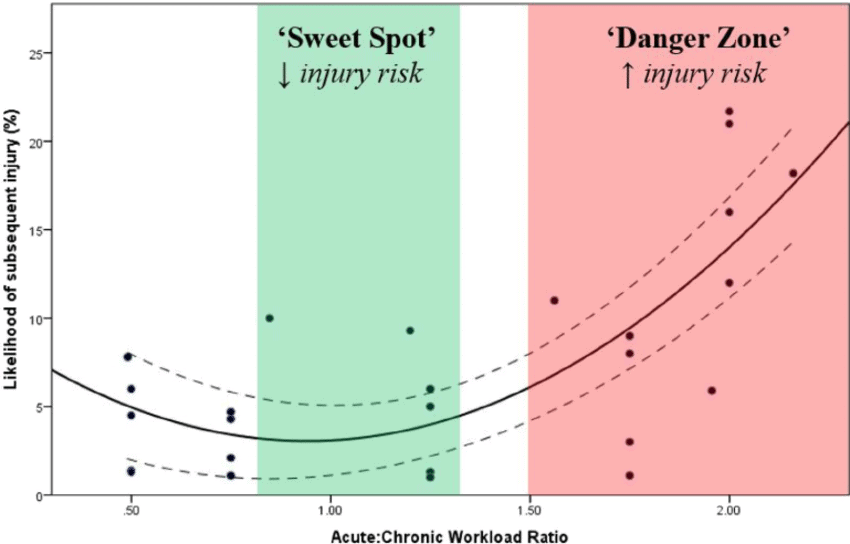- My Forums
- Tiger Rant
- LSU Recruiting
- SEC Rant
- Saints Talk
- Pelicans Talk
- More Sports Board
- Fantasy Sports
- Golf Board
- Soccer Board
- O-T Lounge
- Tech Board
- Home/Garden Board
- Outdoor Board
- Health/Fitness Board
- Movie/TV Board
- Book Board
- Music Board
- Political Talk
- Money Talk
- Fark Board
- Gaming Board
- Travel Board
- Food/Drink Board
- Ticket Exchange
- TD Help Board
Customize My Forums- View All Forums
- Show Left Links
- Topic Sort Options
- Trending Topics
- Recent Topics
- Active Topics
Started By
Message
The Science of the "Ramp Up"
Posted on 8/1/20 at 9:11 am
Posted on 8/1/20 at 9:11 am
Fun Bunch posted a thread the other day titled "Doctor on the Twitters explains why Zion was limited to 15 minutes." A DPT said to "look up acute:chronic workload ratio." I took a deeper dive into the acute:chronic workload ratio (ACWR) and wanted to post what I found, as it helped me better understand the frustrating minutes restriction for Zion, and the science behind it.
Note: I don't know that ACWR is exactly how Aaron Nelson and his staff are figuring the minutes restrictions, but I think this probably falls in line conceptually with WHY he has such highly specific minutes limits. This is not a defense of WHEN the minutes are played (start of quarters vs. end of game) or the lack of transparency from the FO. This just helped me understand the minutes restriction. AWCR seems to be a commonly used metric right now, and is " recommended for use by the International
Olympic Committee to guide training and minimize injury risk."
Quotes in the post come from this article, written by a guy with a degree in Sport Science & High Performance. It is well-written, well-researched, and has a ton of citations for further reading. I also read other academic articles about ACWR, but this one was the most approachable.
What is ACWR?
In ACWR, fatigue is the "acute workload" and fitness is the "chronic workload." Basically, the acute workload is "the workload performed by an athlete in 1-week (7 days)" and chronic workload is the "4-week (28 day) average acute workload." The article uses 'arbitrary units (AU)' to illustrate this:
Calculating chronic workload as a simple average like this is overly simplified and not how this is done in the real world, but it is illustrative.
How do you calculate "workload"?
Two ways: external load and internal load. "External load is the external stimulus applied to the athlete" and generically includes things like: "Total distance, Number of sprints, Player/Body Load, and Weight lifted." Obviously in Zion's case these metrics would be more basketball-specific.
"Internal load is the individual physiological and/or psychological response to external loads, combined with daily life stressors and other environmental and biological factors" and includes things like: "Heart rate, Ratings of perceived exertion, Creatine kinase measures, and Blood lactate concentrations."
When David Griffin says Zion and other players have to meet "certain metrics," I think he is referring to these sorts of metrics, as they ultimately calculate a player's ACWR.
Why does ACWR matter?
Basically, if the ACWR is too high, athletes are at a significantly higher risk for injury.

Zion's ACWR
If the training staff is trying to keep Zion in the "sweet spot" this week (July 26-August 1), we have to look at the previous 4 weeks for guidance:
Week 1 (June 28-July 4): Individual workouts at team facility with team staff (granted waiver by NBA)
Week 2 (July 5-July 11): Individual workouts at team facility with team staff/light workouts at Orlando campus (the beginning of ramp up for the whole roster)
Week 3 (July 12-July 18): Ramping up workouts/??? (Zion left Orlando campus on July 16; obviously nobody knows the extent of his training while attending to his family emergency)
Week 4 (July 19-July 25): ??? (Zion returned to the Orlando campus on July 24)
Depending on the extent of Zion's training while away from the Orlando campus, Zion's ramp up likely took several steps back over the past couple of weeks. Obviously during a family emergency, the reality is that basketball is a secondary consideration (it is just a game after all), so none of this is to denigrate anyone, but rather to hopefully better understand why this is what it is.
If the training staff is being guided by AWCR concepts and we look at Zion's activity the past 4 weeks, it's obvious why he is being heavily restricted, and the science says that this is probably a good thing for injury prevention. Obviously this doesn't help the team's performance in the short term, but with the expected short lag between the end of this season and the start of next, I don't think the team can afford another Zion injury at this juncture. Also, based on this, I would expect Zion to have a minutes restriction for a while as he continues to ramp up.
Note: I don't know that ACWR is exactly how Aaron Nelson and his staff are figuring the minutes restrictions, but I think this probably falls in line conceptually with WHY he has such highly specific minutes limits. This is not a defense of WHEN the minutes are played (start of quarters vs. end of game) or the lack of transparency from the FO. This just helped me understand the minutes restriction. AWCR seems to be a commonly used metric right now, and is " recommended for use by the International
Olympic Committee to guide training and minimize injury risk."
Quotes in the post come from this article, written by a guy with a degree in Sport Science & High Performance. It is well-written, well-researched, and has a ton of citations for further reading. I also read other academic articles about ACWR, but this one was the most approachable.
What is ACWR?
quote:
In 1975, Banister et al [8] proposed that “the performance of an athlete in response to training can be estimated from the difference between a negative function (‘fatigue’) and a positive function (‘fitness’).”
In ACWR, fatigue is the "acute workload" and fitness is the "chronic workload." Basically, the acute workload is "the workload performed by an athlete in 1-week (7 days)" and chronic workload is the "4-week (28 day) average acute workload." The article uses 'arbitrary units (AU)' to illustrate this:
quote:
Let’s suggest an athlete had a weekly average (acute) workload consisting of the following:
Week 1 = 1400 AU
Week 2 = 1200 AU
Week 3 = 1800 AU
Week 4 = 1600 AU
In this case, the 4-week chronic workload value would be the average of these four workloads (1400 + 1200 + 1800 + 1600 / 4 = 1500 AU).
Calculating chronic workload as a simple average like this is overly simplified and not how this is done in the real world, but it is illustrative.
quote:
[ACWR] is calculated by dividing the acute workload (fatigue) by the chronic workload (fitness). For example, an acute workload of 1400 AU may be divided by a chronic workload of 1500 AU, providing an ACWR of 0.93 (1400 / 1500 = 0.93).
How do you calculate "workload"?
Two ways: external load and internal load. "External load is the external stimulus applied to the athlete" and generically includes things like: "Total distance, Number of sprints, Player/Body Load, and Weight lifted." Obviously in Zion's case these metrics would be more basketball-specific.
"Internal load is the individual physiological and/or psychological response to external loads, combined with daily life stressors and other environmental and biological factors" and includes things like: "Heart rate, Ratings of perceived exertion, Creatine kinase measures, and Blood lactate concentrations."
When David Griffin says Zion and other players have to meet "certain metrics," I think he is referring to these sorts of metrics, as they ultimately calculate a player's ACWR.
Why does ACWR matter?
Basically, if the ACWR is too high, athletes are at a significantly higher risk for injury.

quote:
< 0.80 (Under training and higher relative injury risk)
80 – 1.30 (Optimal workload and lowest relative injury risk – “The Sweet Spot”) [7].
> 1.50 (The “danger zone” and highest relative injury risk)
quote:
Research has now subsequently investigated this relationship and found that excessive and rapid increases in training-load are responsible for a large percentage of non-contact soft-tissue injuries [2, 10, 12, 17].
quote:
In a study on Australian Rules football players, it was reported that 40% of injuries were associated with a rapid change (>10%) in weekly (i.e. acute) training-load compared to the previous week [23].
Zion's ACWR
If the training staff is trying to keep Zion in the "sweet spot" this week (July 26-August 1), we have to look at the previous 4 weeks for guidance:
Week 1 (June 28-July 4): Individual workouts at team facility with team staff (granted waiver by NBA)
Week 2 (July 5-July 11): Individual workouts at team facility with team staff/light workouts at Orlando campus (the beginning of ramp up for the whole roster)
Week 3 (July 12-July 18): Ramping up workouts/??? (Zion left Orlando campus on July 16; obviously nobody knows the extent of his training while attending to his family emergency)
Week 4 (July 19-July 25): ??? (Zion returned to the Orlando campus on July 24)
Depending on the extent of Zion's training while away from the Orlando campus, Zion's ramp up likely took several steps back over the past couple of weeks. Obviously during a family emergency, the reality is that basketball is a secondary consideration (it is just a game after all), so none of this is to denigrate anyone, but rather to hopefully better understand why this is what it is.
If the training staff is being guided by AWCR concepts and we look at Zion's activity the past 4 weeks, it's obvious why he is being heavily restricted, and the science says that this is probably a good thing for injury prevention. Obviously this doesn't help the team's performance in the short term, but with the expected short lag between the end of this season and the start of next, I don't think the team can afford another Zion injury at this juncture. Also, based on this, I would expect Zion to have a minutes restriction for a while as he continues to ramp up.
Posted on 8/1/20 at 9:50 am to greewe
Not reading all that but here’s an upvote for your hard work.
Posted on 8/1/20 at 10:31 am to greewe
Damn man. This is awesome. 
A lot is a bit over my head but I get the gist. Awesome.
A lot is a bit over my head but I get the gist. Awesome.
Posted on 8/1/20 at 11:32 am to Fun Bunch
This is what Griff should have been leading with from the start. Griff needs to make Aaron Nelson a hero instead of letting fans decide he's a goat. Saying nothing and leaving Uncle Al and Zion alone to figure out how to answer why he's not playing when nothing's "wrong" has been a tire fire.
This post was edited on 8/1/20 at 11:34 am
Posted on 8/1/20 at 11:50 am to greewe
I’m starting masters school in Exercise Science and after hopefully PT school and everything you’ve said is what I’ve been learning the last few semesters. The ramping up process is all individualistic so players “ramp time” is different so hopefully with Zion being young his will be shorter...
Cool seeing it be applied, just sucks watching us drop games we can win.
Cool seeing it be applied, just sucks watching us drop games we can win.
Popular
Back to top
 3
3






